Evaluation of Canadian Heritage’s Communications Services 2015-16 to 2017-18
Evaluation Services Directorate
November 12, 2019
Cette publication est aussi disponible en français.
On this page
- List of tables
- List of figures
- List of acronyms and abbreviations
- 1. Introduction
- 2. Description of Communications Services
- 3. Approach and methodologies
- 4. Evaluation findings
- 5. Conclusions and recommendations
- 6. Management response and action plan
List of tables
- Table 1: distribution of PCH communications services and products
- Table 2: recommendation 1 – action plan
- Table 3: recommendation 2 – action plan
- Table 4: recommendation 3 – action plan
List of figures
- Figure 1: evolution of PCH’s Communications Services
- Figure 2: PCH Communications Services Organizational Chart
- Figure 3: distribution of companies and employees, from 2013-2014 to 2017-2018
- Figure 4: organizational structure chart of the PCH Communications Services organizational structure
- Figure 5: planned and actual budget (Communications Department)
- Figure 6: planned and actual budget (PCH)
- Figure 7: full-time equivalent (PCH)
- Figure 8: full-time equivalent (Communication Services)
List of acronyms and abbreviations
- CA
- Cultural Affairs
- CHR
- Citizenship, Heritage and Regions
- DR
- Direct Reports
- FTE
- Full-Time Equivalents
- GC
- Government of Canada
- ISED
- Innovation, Science and Economic Development
- PCH
- Canadian Heritage
- PCO
- Privy Council Office
- SMEC
- Sport, Major Events and Commemorations
- SPPCA
- Strategy Policy, Planning and Corporate Affairs
1. Introduction
This report presents the findings of the evaluation of Canadian Heritage’s (PCH) Communications Services. The evaluation was conducted in accordance with the Treasury Board of Canada Secretariat's 2016 Policy on Results.
The evaluation was undertaken in accordance with the commitments to evaluate PCH internal services as set out in the 2018-19 to 2022-23 Departmental Evaluation Plan.
PCH Communications Services – which includes the Communications Branch and the communications regional offices – has never been evaluated in the past. The evaluation covered the period from 2015-16 to 2017-18. Although the evaluation focused on the services and products offered by Communications Branch, regional Communications offices were also included. As such, a case study was undertaken on regional offices, which included interviews and a document review. A survey was also sent to all PCH employees, including those in the regions.
2. Description of Communications Services
2.1. Government of Canada’s Communications Services
Communications Services allow the Government of Canada (GC) to communicate with the public in both official languages and to inform Canadians of policies, programs, services and initiatives. The Policy on Communications and Federal IdentityFootnote 1 highlights the role and responsibilities of Communications Services.
Communications Services ensure that GC’s communications to the public are non-partisan, effectively managed, well-coordinated, clear and responsive to the diverse information needs of the public. Communications Services also provide impartial advice and support the Minister, who is the principal spokesperson for the Department, in communicating government policies, programs, priorities and decisions to the public.
2.2. PCH’s Communication Services
As of September 2019, the immediate clients of PCH’s Communications Services are the three Ministers’ offices – Minister of Canadian Heritage and Multiculturalism, Minister of Science and Sport, and Minister of Tourism, Official Languages and La Francophonie – as well as PCH’s programs.
Between July 2018 and September 2019, Communications Services at PCH are required to coordinate with Innovation, Science and Economic Development’s (ISED) Communications Services in the delivery of communications products for the Minister of Science and Sport and the Minister of Tourism, Official Languages and La Francophonie.
The primary audience of the products developed by PCH’s Communications Services is the Canadian public for external communications and PCH employees for internal communications.
Key stakeholders include, but are not limited to, programs’ sector stakeholders (cultural, arts, sports, etc.) and media.
For 2018-19, the Communications Branch’s reference levels were $11,068,770 and there were 104,7 planned FTEsFootnote 2.
Whether at headquarters or in regional offices, the account executive (one point of contact) is the hub between the various communications services of the Communications Branch and the programs, for all requests involving public communications.
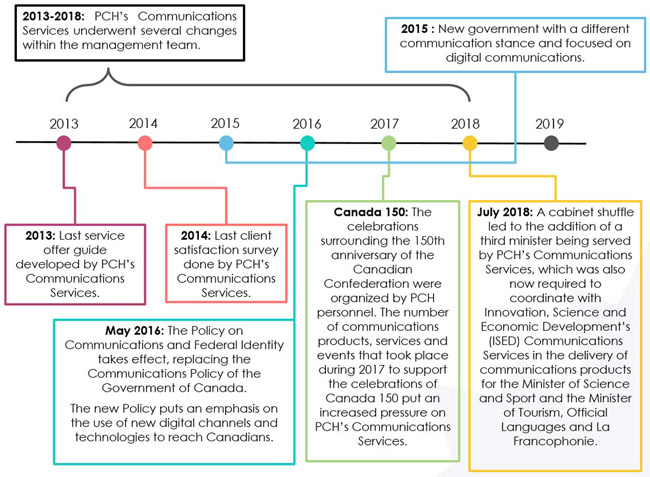
Figure 1: evolution of PCH’s Communications Services – text version
2013-18: PCH’s Communications Services underwent several changes within the management team.
2013: last service offer guide developed by PCH’s Communications Services.
2014: last client satisfaction survey done by PCH’s Communications Services.
2015: new government with a different communication stance and focused on digital communications.
May 2016: the Policy on Communications and Federal Identity takes effect, replacing the Communications Policy of the Government of Canada.
The new Policy puts an emphasis on the use of new digital channels and technologies to reach Canadians.
Canada 150 (2017): the celebrations surrounding the 150th anniversary of the Canadian Confederation were organized by PCH personnel. The number of communications products, services and events that took place during 2017 to support the celebrations of Canada 150 put an increased pressure on PCH’s Communications Services.
July 2018: a cabinet shuffle led to the addition of a third minister being served by PCH’s Communications Services, which was also now required to coordinate with Innovation, Science and Economic Development’s (ISED) Communications Services in the delivery of communications products for the Minister of Science and Sport and the Minister of Tourism, Official Languages and La Francophonie.
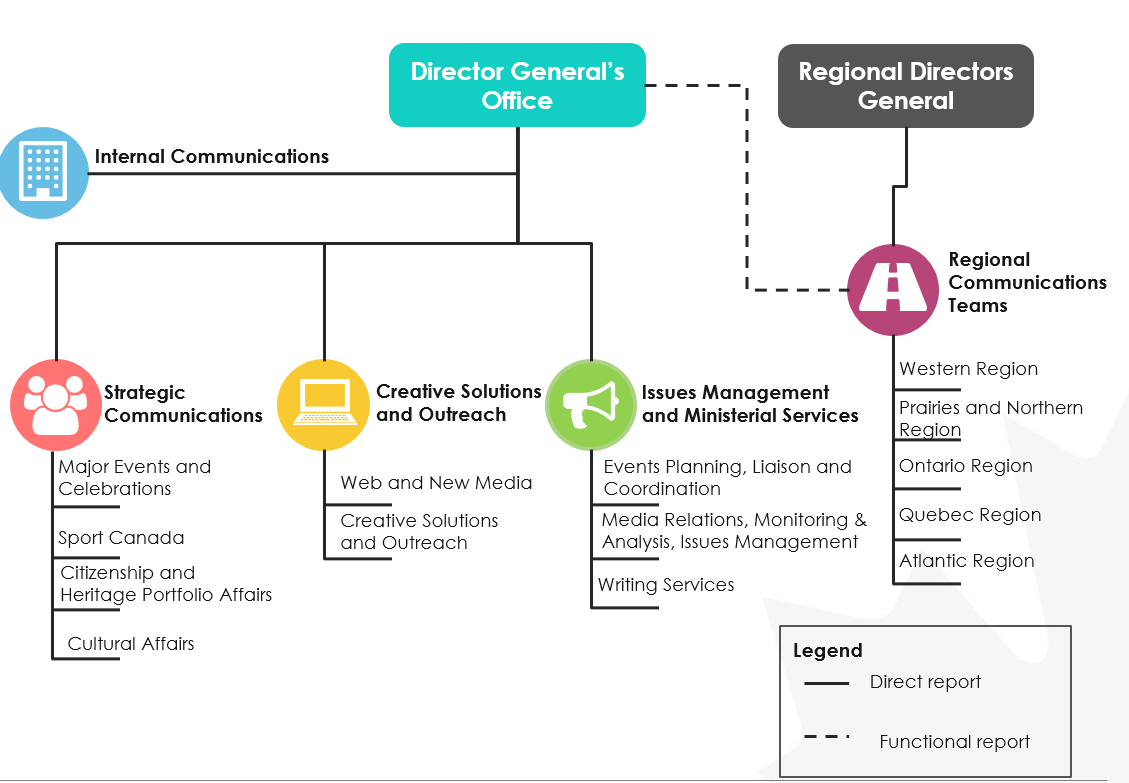
Figure 2: PCH Communications Services organizational chart – text version
Director General’s Office (Direct Report to the teams below)
- Internal Communications
- Strategic Communications
- Major Events and Celebrations
- Sport Canada
- Citizenship and Heritage Portfolio Affairs
- Cultural Affairs
- Creative Solutions and Outreach
- Web and New Media
- Creative Solutions and Outreach
- Issues Management and Ministerial Services
- Events Planning, Liaison and Coordination
- Media Relations, Monitoring & Analysis, Issues Management
- Writing Services
A functional report exists between the Director General’s Office and the regional Communications teams. The regional teams report to the Regional Directors General.
- Western Region
- Prairies and Northern Region
- Ontario Region
- Quebec Region
- Atlantic Region
3. Approach and methodologies
3.1. Evaluation questions
The approach and scope of the evaluation was established during the planning phase, which included consultations with senior management from PCH’s Communications Services.
Evaluation questions
- 1. What is the mandate of PCH’s Communications Services (e.g. mission statement, vision)?
- 2a. Are the products and services offered by PCH’s Communications Services well defined?
- 2b. Are the products and services offered by PCH’s Communications Services aligned with current policies?
- 3. To what extent are the services and products of PCH’s Communications Services meeting the needs of their clients?
- 4. How are PCH’s Communications Services products and services rendered?
- 5. To what extent is PCH’s Communications Services’ organizational structure most effective to support products and services?
- 6. To what extent has PCH’s Communications Services conducted its operations efficiently?
3.2. Limitations of the methodology
- This evaluation is based primarily on qualitative data obtained through key stakeholder interviews and from the survey sent to PCH employees.
- As this was the first evaluation of Communications Services as an internal service, there were no data regarding performance and achievement of results.
- Few documents relevant to the evaluation were available or up to date. Some of the documents obtained from the comparison with other departments were confidential in nature and were not shared with the evaluation team.
- While the wealth of information obtained from the interviews and the survey provided useful findings and conclusions for evaluation purposes, systematic collection of information regarding performance and achievement of results would have allowed for a more in-depth analysis of certain themes or questions.
- The scope of the evaluation was limited to focus on key organizational problems. For example, the evaluation looked at the account executive model, but did not evaluate the entire organizational structure of Communications Services.
3.3. Data sources
The evaluation used multiple data sources, both qualitative and quantitative, to triangulate the results.
Interview
Interviews undertaken between February and May 2019 with:
- 20 Communications employees
- 11 Communications managers
- 10 PCH managers
Documentary review
119 documents analyzed, including:
- communications plans
- events trackers
- presentations to clients
- work processes
- post-event review
- financial data
- file tracking
Survey
- Sent in April 2019 to 1,808 PCH employees working across Canada
- 573 responses received
- Response rate of 32%
Case study
3 case studies completed between March and June 2019 (including documentary review and interviews with key branch and regional stakeholders):
- communications events
- interaction with ministerial offices
- interaction with regional offices
Comparative models
Analysis of Communications Services at four other federal departments:
- Agriculture and Agri-Food Canada (AAFC)
- Immigration, Refugees, and Citizenship Canada (IRCC)
- Transport Canada (TC)
- Natural Resources Canada (NRCan)
4. Evaluation findings
4.1. Mandate of PCH’s Communications Services
Evaluation question 1: what is the mandate of PCH’s Communications Services?
Key finding: while no official mandate was found, the mandate of PCH’s Communications Services was described as offering products and services to PCH’s programs and Ministers’ offices, in order to inform Canadians.
Two mandates emerged from the Communications interviewees:
- A majority of Communications interviewees (65%) stated that the mandate of Communications Services Branch is to inform Canadians, by a variety of means, of PCH’s policies, programs, events, services and how they can access them.
- A majority of Communications interviewees (58%) were also of the opinion that the mandate of Communications Services is to offer advice and guidance to both PCH’s programs and the Ministers’ offices.
58% of Communications interviewees were of the opinion that these two mandates were adequate and 81% of Communications managers interviewed stated that these two mandates were aligned with the Policy.
Regional communications employees were of the opinion that their mandate was broader than the one of the Communications Branch, but felt that their activities align well with the Communications Branch’s mandate.
Half of the clients interviewed did not get a clear explanation of the mandate of PCH’s Communications Services. However, they described their perception of PCH’s Communications Services mandate as offering both internal and external communications products and services. Also, some of PCH’s managers interviewed were of the opinion that the mandate of PCH’s Communications Services was mainly geared toward offering services and products to the Ministers’ offices.
4.2. Products and services offered by the communications
Evaluation question 2a: are the products and services offered by PCH’s communications services well defined?
Key finding: PCH’s Communications Services does not have an established and clearly defined service offering. However, the evaluation was able to develop a list of communications products and services offered.
In 2013, Communications Services developed a Client Services Guide detailing all the products and services offered. Although this guide has not been updated, the evaluation team was able to draft a list of products and services offered, based on documents reviewed, that is similar to the ones offered in 2013 for internal and external communications.
58% of clients surveyed believed that PCH’s Communications Services’ products and services were clearly defined.
Case studies indicate that the majority of internal and external communications products and services are the same, whether delivered by regional offices or the Communications Branch.
The four other departments reviewed have clearly defined communications products and services. These range from traditional products such as press releases, advertising and speech writing, to digital services, online engagement and content marketing strategies deployed through social media channels and the web.
4.2.1. Internal communicationsFootnote 3
Intranet publications “Showcase” section and “Spotlight” section
Most survey respondents:
- could easily find useful information on the intranet (59%);
- found that the Showcase section helped promote PCH initiatives (72%) and employee achievements (60%);
- believed that the Spotlight section was a good way to emphasize upcoming events (63%).
However, some respondents in the survey raised the following issues:
- information is often outdated (27%);
- search function is outdated (19%);
- too much information and the sections are not clearly organized (17%)
- information too focused on the national office (8%).
Emails to PCH employees and message on digital screens
Among survey respondents:
- most PCH managers (53%) found that Let’s Talk! emails provided them with useful information.
- almost all employees at headquarters (90%) and most employees in the regions (74%) said that News@PCH emails provide useful updates.
- most employees (59%) felt that digital screens are effective in transmitting internal communications messages.
However, some respondents in the survey raised the following issues:
- some respondents (12%) noted that there was sometimes too much information in the emails they received and that the content could be presented in a more dynamic way.
- a few respondents (10%) mentioned that screens are not located in strategic locations and that the content shared is sometimes overloaded with information or scrolls too fast.
4.2.2 External communicationsFootnote 4
Planning and advice
- Communications plans
- Strategic advices
- Coordination of various communication products
- Information documents for senior management
Communications products
- Media advisories
- Media lines
- News releases
- Social media and Web
- Speeches and video messages
- Creative solutions
Logistics products
- Biographies
- Guest lists
- Invitations
- Questions and answers
- Sequence of events
Just over half of communications personnel (51%) said that the products and services offered by Communications Services were accessible to everyone. Others (23%) instead indicated that some products and services were reserved for ministerial events.
Some communications products and services – including media lines, speeches, guest lists, biographies, invitations, etc. – are reserved for ministerial events and are not offered to all programs.
Since July 2018, PCH’s Communications Services has served three ministers and align their services with those offered by ISED for two ministers. Adding a third minister placed greater pressure on communications staff.
Evaluation question 2b: are the products and services offered by PCH’s Communications Services aligned with current policies?
Key finding: the evaluation found that the services and products offered by PCH’s Communications Services were aligned with the Policy.
90% of Communications personnel interviewed stated that the products and services offered were aligned with the Policy. For example, the Communications Branch interacts regularly with regional offices to maintain consistency at the national level, ensure that communications are offered in both official languages, uses various digital platforms to communicate with Canadians, and ensures that PCH employees can communicate with each other using the internal communications service.
Employees at Communications Services ensure that all products and services offered to Ministers’ offices are non-partisan, to comply with the Policy.
The section 6.11. of the Directive on the Management of Communications states that Communications Services should be:
“Using digital media and platforms as the primary means to connect and interact with the public while continuing to use multiple communications channels to meet the diverse information needs of the public.”
As with the other departments examined, PCH is making a transition to digital service delivery. For example, in 2017 and 2018, PCH published 17,220 times through its 30 separate digital channels. As well, over two years, the channels have gained:
- 29,415 Instagram followers
- 120,796 Facebook followers
- 77,701 Twitter followers
Evaluation question 3: to what extent are the services and products of PCH’s Communications Services meeting the needs of their clients?
Key findings:
- In line with other departments, PCH’s Communications Services is moving away from a traditional approach of offering services and are rather increasingly focusing on offering strategic communications advice.
- Clients satisfaction varied between the different sectors within PCH.
- PCH’s Communications Services does not have a systematic approach to assess clients’ satisfaction.
PCH’s Communications Services are moving away from a service-based offer and are rather aiming to offer strategic communications advice, in order to meet their client’s needs and reach target audiences.
This shift is putting increasing pressure on the account executive (strategic communications) to be experts in a large variety of products and services – going from traditional press releases to new digital services such as social media and Internet content.
Among the actions undertaken and challenges observed within the other four departments examined who are also transitioning from offering services to offering advice:
- some departments are questioning the new role of strategic communications, as they increasingly need to be expert on a broad range of services;
- most departments are increasingly collecting data and intelligence and are establishing key performance indicators to assess the success of products and services.
The shift toward offering strategic advice rather than being a service provider must be adapted when a ministerial priority arises. As case studies highlighted, when a Minister’s office makes a request, it immediately becomes a priority. Priority requests result in a redistribution of operational requirements and can cause delays in addressing other work tasks.
70% of PCH’s managers interviewed were of the opinion that the services and products offered by Communications Services adequately served their needs.
Furthermore, 60% of PCH’s managers interviewed had suggestions to improve the services and products offered, such as:
- reducing the number of internal communications and improving the feedback given to clients for products that are featured on the intranet;
- offering content writing services or strategic advice on content writing to clients;
- improving the quality of the services and products and ensuring that the quality of service offerings are consistent from one client to the other.
When PCH’s employees surveyed (within NHQ and regions, but excluding Communications employees) were asked how satisfied they were with Communications Services’ responsiveness toward their evolving communications needs, half of respondents expressed that they were satisfied. However, satisfaction varied between sectors. For example, the Citizenship, Heritage and Regions sector scored the lowest in the overall satisfaction, while the Cultural industries and the Direct Reports sectors scored the highest.
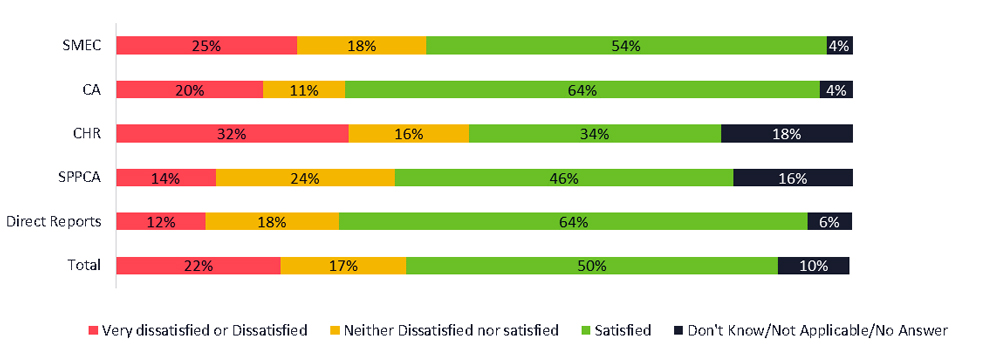
Figure 3: distribution of companies and employees, from 2013-2014 to 2017-2018 – text version
| Level of Satisfaction | DR | SPPCA | CHR | CA | SMEC |
|---|---|---|---|---|---|
| Very dissatisfied or Dissatisfied | 12% | 14% | 32% | 20% | 25% |
| Neither Dissatisfied nor satisfied | 18% | 24% | 16% | 11% | 18% |
| Satisfied | 64% | 46% | 34% | 64% | 54% |
| Don't Know/Not Applicable/No Answer | 6% | 16% | 18% | 4% | 4% |
| Total | 100% | 100% | 100% | 100% | 100% |
This satisfaction level is similar to the one observed among clients of Communications Services across departments. A survey conducted by the Privy Council Office (PCO) in 2019 across 43 departments and agencies found that 54% of Communications Services’ clients agreed or strongly agreed that their department Communications’ team provided the communications tools and support needed to deliver programs effectively.
A majority of Communications managers interviewed (60%) and most PCH managers interviewed (80%) stated that a review of the client’s satisfaction in regard to Communications services and products was not done systematically or formally.
Interviewees explained that assessments of satisfaction were not done consistently and were usually conducted when something did not go as planned.
Other departments examined discussed conducting client surveys, though they acknowledged the difficulty of conducting surveys due to “survey fatigue” of employees.
A recent client survey was undertaken by PCO to assess departmental satisfaction with the products and services of their respective Communications Services branches.
64% of PCH employees surveyed stated that they were satisfied with overall client experience with Communications Services. However, no employee stated that they were very satisfied with their overall client experience.
Last time that PCH’s Communications Services conducted an internal survey to assess their client’s satisfaction toward the services and products offered was in 2014. The issues raised in the 2014 survey are similar to the ones observed as part of this evaluation, such as:
- lack of clarity surrounding roles and responsibilities;
- lack of consistency in the quality of the products received;
- perception that Communications Services are mainly focused on offering services and products to the Ministers’ offices.
Evaluation question 4: how are PCH’s Communications Services products and services rendered?
Key findings:
- The existence of clear processes, procedures and service standards to accomplish tasks varies depending on the Communications Services teams.
- The timeline required by Communications Services to carry out the requested tasks are rarely respected by clients.
29% of Communications Services employees interviewed believed that the procedures and processes could be reviewed, improved and better communicated to communications staff and clients.
The four departments examined in the analysis of alternative models used the account executive model and were of the view that their procedures and work processes were clear and understood by their Communications Services employees.
Given the various changes in the role of Communications Services, some adopted a more collaborative work method between strategic and operational teams and created interfunctional teams to provide products and services.
Some managers within Communications Services noted that, while some data regarding performance and service standards was available, there was not enough time to conduct a thorough analysis.
| Processes and procedures | Services standardsFootnote 5 | |
|---|---|---|
| Communication strategies |
|
|
| Creative Solutions and Outreach |
|
|
| Issues Management and Ministerial Services |
|
|
Meeting service standards
Some communications staff explained that service standards are not intended to measure the performance of Communications Services, but rather to indicate to clients—particularly to Ministers’ offices—the time required by Communications Services to respond to requests. Despite this, the timelines indicated by Communications Services to perform a task are rarely respected by clients.Footnote 6 They frequently request products and services more quickly than what is indicated in the service standards.
For example, between July and October 2018, of the 94 requests received from the three ministerial offices, 49% did not respect the service standards established by the Privy Council Office.
50% of PCH managers interviewed noted that they often submitted urgent requests to obtain communications products and services and those requests often did not respect the timelines set out for service standards. However, managers noted with appreciation that the products requested were always delivered according to program needs.
52% of Communications Services employees stated that they were not measuring the achievement of their service standards. Respondents explained that it would not be useful to do so, as client requests do not always respect their standards.
Evaluation question 5: to what extent is PCH’s Communications Services organizational structure most effective to support products and services?
Key findings:
- Communications Services’ organizational structure and the account executive model have benefits and limitations, as highlighted by the multiple lines of evidence.
- Inconsistent skills and knowledge were identified, particularly around digital and social media among communication personnel.
Overall, SMEC, CA and DR were more satisfied with the Account Executive model (one point of contact) and the services received than CHR and SPPCA.
Advantages of the account executive model
- One point of contact for clients, which makes it easy for them to know who to contact when they need communications products and services.
- The account executives are able to sort through all the requests received by Communications Services and redirect people that are looking for services outside of the Communications’ mandate.
- The relationship of trust that develops between the account executive and its clients allow them to offer strategic communications advice that are well received and listened to.
Challenges of the account executive model
- Increased pressure is put on account executives to be experts on all the products and services offered.
- Account executive acts as the « middle man », which sometimes creates an unnecessary extra step between Communications Service providers and the client. Having to go through the account executive sometimes slows things down.
In theory, the structure for programs and Ministers’ offices to access Communications Services is well defined, but in practice, some clients bypass their account executive or the Events Planning and Liaison Unit (EPLU) and go directly to the services they want. The process to access services is then inconsistent.
The procedures to include the regions, especially when planning ministerial trips, are not clearly defined or understood. The interactions between the regions and the different teams within the Communications Branch are also unclear.

Figure 4: organizational structure chart of the PCH Communications Services organizational structure – text version
For programs that want to access Communications Services, the formal process indicates that they must deal with their Account Executive. The latter will liaise with the specialized Communications Services teams, such as Writing Services, Social Media Services, Web Services, Media Relations Services, Creative Solutions Services and Media monitoring and Analysis Services.
However, an unofficial process for accessing the services listed above is sometimes used by programs, who go directly to the service they need.
There is a formal process that outlines the interaction between programs and regions.
For Ministers' Offices who wish to access communications services, the formal process indicates that they must deal with the Event Planning and Liaison Unit (EPLU). This unit will liaise with specialized Communications Services teams, such as Writing Services, Social Media Services, Web Services, Media Relations Services, Creative Solutions Services and Media monitoring and Analysis Services.
However, an unofficial process for accessing the services listed above is sometimes used by Minister's Offices, which go directly to the service they need.
An unofficial process exists when Minister’s Offices interact with Regions.
The interaction between the Regions and the various Communications services is not always well defined.
The interaction between Regions and EPLU is not well defined.
Interaction with regional offices
One of the biggest challenge in delivering products and services through the current approach is maintaining communication between the regions and the Communications Branch, which can be done through regular meetings or team retreats. Regular interactions between the Communications Branch and regional offices ensure that:
- organizational changes in the Communications Branch are communicated to regional offices;
- consistency of approaches are maintained.
The evaluation found that the regional communications employees are an efficient and cost-effective support for the Communications Branch. The regional offices allow communications services to have local logistical support during regional ministerial events. Regional communications employees are also aware of the different events taking place in their region and have in-depth knowledge of the local key stakeholders and organizations.
However, some challenges were raised:
- regional offices report to Regional Directors General - not the Director General of Communications Services. The accountability to ensure that communications products are compliant with the Policy lies with the Director General of Communications and as a result, the Communications Branch has to review all products and services from the regional offices. However, the Regional Directors General are accountable on the content of the communications products and must ensure that the content communicated is accurate.
- it is more difficult for regional offices to fully embrace the digital shift prescribed in the Policy, as they do not have a direct access to the various digital channels of PCH (e.g. Instagram, Facebook, etc.). Footnote 7
- some regions identified a lack of a close working relationship between the regional offices and the Communications Branch; procedures and products are not as efficient as they could be.
Tasks and trainings description
52% of Communications employees and managers interviewed were of the opinion that the job descriptions and positions were adequate to fulfill Communications Services mandate and to deliver services. Efforts were also made by Communications personnel to update the job description and reclassify the positions as needed.
39% of all interviewees were of the opinion that some Communications employees lacked social media and web knowledge, which created unnecessary delays and set unrealistic expectations from clients on what could be done through those digital channels.
These skills are increasingly important, as the Directive on the Management of Communications states that communications services should be using ‘’digital media and platforms as the primary means to connect and interact with the public’’.
55% of Communications employees and managers interviewed were of the opinion that the Communications personnel did possess the skills to respond to present and future challenges.
Some interviewees noted challenges such as:
- high turnover in Communications personnel due to the rarity of IS (Information Services) candidates, as well as the lack of promotion opportunity within PCH’s Communications Services’ teams.
Evaluation question 6: to what extent has PCH’s Communications Services conducted its operations efficiently?
The actual operating expenditures of the Communications Branch (excluding the regional offices) represented on average 5.53% of PCH’s total operating expenditures.
Between 2015 and 2019, the Communications Branch exceeded its reference level by an average of 10.10%, ranging from a 3.39% budget overspending in 2015-16 to 4.06% budget overspending in 2018-19, with a peak at 20.01% in 2017-18. This peak coincides with Canada 150 that took place in 2017, an event that put increased pressure on Communications Services. In comparison, PCH exceeded its reference level by an average of 4.38% between 2015 and 2019.
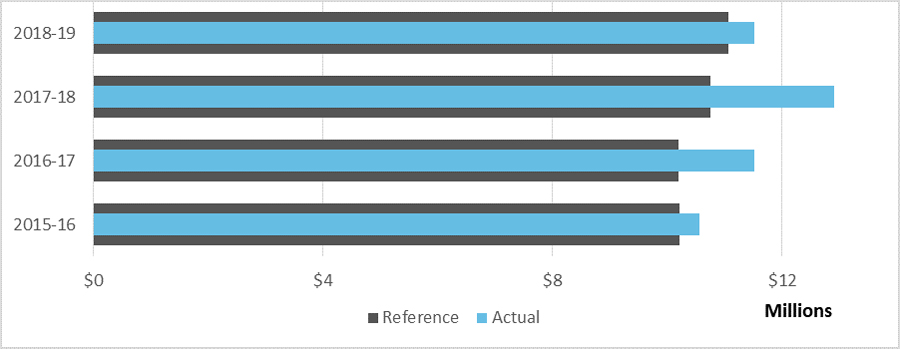
Figure 5: planned and actual budget (Communications Department) (in millions of dollars) – text version
| Reference | Actual | |
|---|---|---|
| 2015-16 | $10,218,564.00 | $10,565,061.09 |
| 2016-17 | $10,198,135.00 | $11,519,172.97 |
| 2017-18 | $10,755,496.00 | $12,908,147.35 |
| 2018-19 | $11,068,770.00 | $11,518,148.00 |
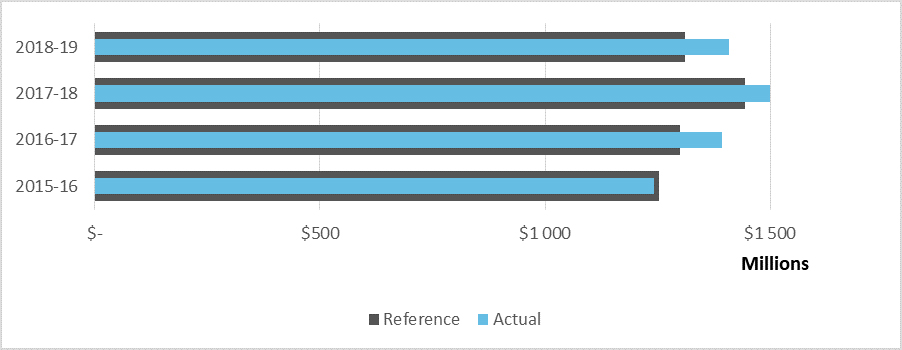
Figure 6: planned and actual budget (PCH) (in millions of dollars) – text version
| Reference | Actual | |
|---|---|---|
| 2015-16 | $1,253,356,561.00 | $1,240,947,324.00 |
| 2016-17 | $1,299,498,160.00 | $1,393,267,923.00 |
| 2017-18 | $1,444,696,770.00 | $1,499,066,633.00 |
| 2018-19 | $1,310,822,919.00 | $1,409,564,221.00 |
Between 2015 and 2019, the number of Full-Time Equivalents (FTEs) in the Communications Branch (excluding the regional offices) increased by 8.72%, going from 94 FTE in 2015-16 to 102.2 FTE in 2018-19. This increase is similar to the one observed within PCH, where FTEs increased by 8.26%, going from 1.744 in 2015-16 to 1.888 in 2018-19.
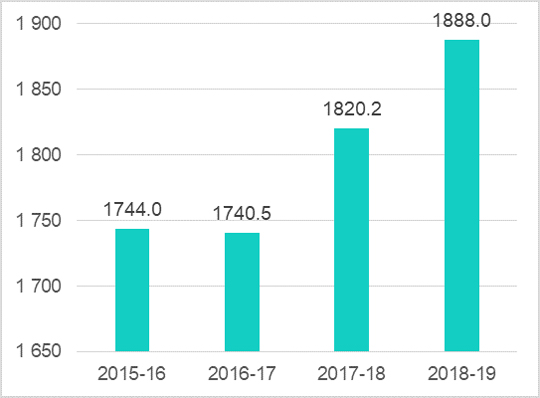
Figure 7: full-time equivalent (PCH) – text version
| 2015-16 | 2016-17 | 2017-18 | 2018-19 |
|---|---|---|---|
| 1744.0 | 1740.5 | 1820.2 | 1888.0 |
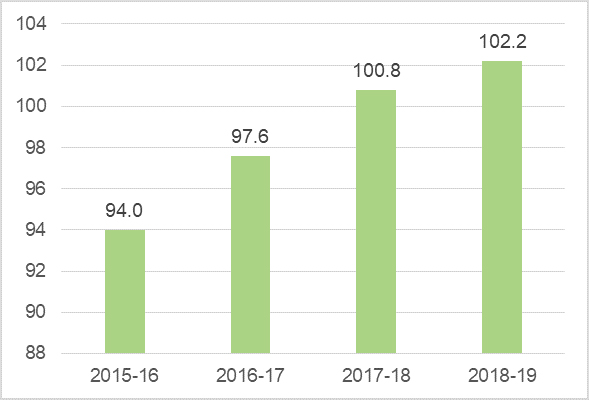
Figure 8: full-time equivalent (Communications Services) – text version
| 2015-16 | 2016-17 | 2017-18 | 2018-19 |
|---|---|---|---|
| 94.0 | 97.6 | 100.8 | 102.2 |
To assess the efficiency of the Communications Branch’ operations, the evaluation looked at Communications Services’ FTE as a percentage of PCH’s total FTE. Between 2015 and 2019, Communications Services’ FTEs represented on average 5.51% of PCH’s total FTE.
5. Conclusions and recommendations
5.1. Conclusions
Key issues observed within PCH’s Communication Services
- Issue 1: the mandate of Communications Services and the services offered are not explicitly defined
- No mandate was found in the documents. Moreover, 1 of 5 Communications Services employees interviewed indicated that there was no clearly defined mandate. According to Communications Services employees and managers interviewed, the mandate was not understood by clients (both by programs and by Ministers’ offices).
- 81% of communications managers interviewed indicated that the products and services offered were not clearly defined or understood by communications staff or clients.
- Issue 2: the roles and responsibilities of Communications Services are not clearly defined and understood
- 30% of Communications Services employees and PCH managers interviewed indicated that the roles and responsibilities of Communications Services and its clients are not clearly defined or understood, both by Communications Services staff and clients.
- The ambiguous roles and responsibilities of Communications Services employees and of their clients are reflected in the lack of clarity or consistency in procedures and processes regarding the creation, approval and quality of the products and services offered.
The consistency issues and inequality in products and services offered from one client to another is affecting the clients’ satisfaction. Moreover, some account executives offer products and services that exceed the roles and responsibilities of Communications Services.
5.2. Recommendations
Recommendation 1:
To improve the understanding of the communications function at PCH among clients and employees of Communications Services and to allow communications services to carry out its roles and responsibilities in a world in transition from a traditional approach to a more strategic approach to communications. The evaluation recommends that:
The Director General of Communications Branch, in collaboration with the Assistant Deputy Minister, Official Languages, Heritage and Regions, provide Communications Services with a clear mandate that formally defines the roles and responsibilities of the Communications Branch and the regional offices.
Recommendation 2:
An important issue raised in the evaluation was the inequality of the products and services offered, which are not equally available to all clients. This lack of consistency affects the satisfaction of the various groups of Communications Services’ clients. The evaluation recommends that:
The Director General of Communications Branch, in collaboration with the Assistant Deputy Minister, Official Languages, Heritage and Regions, develop and distribute its service offer to its employees and clients, including the required timelines and the service standards.
Recommendation 3:
One of the main limitations of this evaluation is that it was based primarily on qualitative data from the interviews and the survey conducted. Indeed, Communications Services was being evaluated for the first time and limited data on performance or results was available. The evaluation recommends that:
The Director General of Communications Branch implement a systematic collection of certain performance data, which would make it possible to measure the achievement of targets, to further pursue the analysis of certain issues and to make changes as required.
6. Management response and action plan
| Recommendation | Management response | Action plan | Timeline | Responsible |
|---|---|---|---|---|
| The Director General of Communications Branch, in collaboration with the Assistant Deputy Minister, Official Languages, Heritage and Regions, provide Communications Services with a clear mandate that formally defines the roles and responsibilities of the Communications Branch and the regional offices. | In agreement. A management framework for Communication Services will be developed | Modernize the mandate of Communications Services and share with all employees of the Communications Branch and regional offices | Dec. 2019 | Director General of the Communications Branch in collaboration with the regions |
| The Director General of Communications Branch, in collaboration with the Assistant Deputy Minister, Official Languages, Heritage and Regions, provide Communications Services with a clear mandate that formally defines the roles and responsibilities of the Communications Branch and the regional offices. | In agreement. A management framework for Communication Services will be developed | Establish and document the roles and responsibilities of Communications Services | June 2020 | Director General of the Communications Branch in collaboration with the regions |
| Recommendation | Management response | Action plan | Timeline | Responsible |
|---|---|---|---|---|
| The Director General of Communications Branch, in collaboration with the Assistant Deputy Minister, Official Languages, Heritage and Regions, develop and distribute its service offer to its employees and clients, including the required timelines and the service standards. | In agreement. A service offer document will be developed | Clarify and modernize the list of communications services provided by the Communications Branch and regional offices | June 2020 | Director General of the Communications Branch in collaboration with the regions |
| The Director General of Communications Branch, in collaboration with the Assistant Deputy Minister, Official Languages, Heritage and Regions, develop and distribute its service offer to its employees and clients, including the required timelines and the service standards. | In agreement. A service offer document will be developed | A service offer for Ministers' offices will be completed and documented as a priority | Dec. 2019 | Director General of the Communications Branch in collaboration with the regions |
| The Director General of Communications Branch, in collaboration with the Assistant Deputy Minister, Official Languages, Heritage and Regions, develop and distribute its service offer to its employees and clients, including the required timelines and the service standards. | A service offer document will be developed | Consult programs, management tables and regions to validate the service offer | June 2020 | Director General of the Communications Branch in collaboration with the regions |
| The Director General of Communications Branch, in collaboration with the Assistant Deputy Minister, Official Languages, Heritage and Regions, develop and distribute its service offer to its employees and clients, including the required timelines and the service standards. | A service offer document will be developed | Make the modernized service offer available to the entire Department and inform employees of the Communications Branch and all employees of the Department. | June 2020 | Director General of the Communications Branch in collaboration with the regions |
| recommendation | Management response | Action plan | Timeline | Responsible |
|---|---|---|---|---|
| the Director General of Communications Branch implement a systematic collection of certain performance data, which would make it possible to measure the achievement of targets, to further pursue the analysis of certain issues and to make changes as required. | In agreement. Develop a strategy to identify the methodology for collecting certain performance data | Implement the strategy to collect the results of the performance indicators. | Dec. 2020 | Director General of the Communications Branch in collaboration with the regions |
©Her Majesty the Queen in Right of Canada, 2019
Catalogue No.: CH7-63/1-2019E-PDF
ISBN: 978-0-660-33250-5
Page details
- Date modified:
